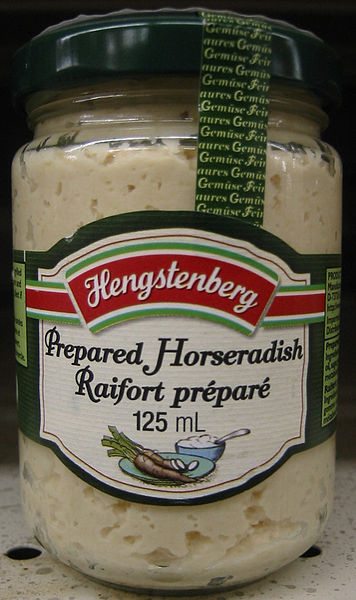Facts
History: The Egyptians used horseradish over 3000 years ago but it is not known what the common use was. In Greece it was used to alleviate lower back pain as well as an aphrodisiac. It has been used as a cough medicine and thought to have cured rheumatism and tuberculosis. In a message from an oracle to Apollo, it is stated that the horseradish is worth its weight in gold. Horseradish became very popular in England 1600’s as it started to be a staple condiment with beef and oysters which eventually made its way to America with emigration. Apparently, 6 million gallons of horseradish are prepared annually in the US.
Trivia: Horseradish is still planted and harvested mostly by hand.
Sales of bottled horseradish began in 1860, making it one of the first convenience foods.
In the American South, horseradish was rubbed on the forehead to relieve headaches.
Horseradish is added to some pickles to add firmness.
Before being named "horseradish," the plant was known as "redcole" in England and as "stingnose" in some parts of the U.S.
Horseradish has only 2 calories a teaspoon.
Researchers at M.I.T. claim that the enzyme "horseradish peroxidase" removes a number of pollutants from waste water.
The most widely recognized horseradish fan in the world may be Dagwood Bumstead, who consumed it regularly in the popular comic strip, "Blondie," by Dean Young and Stan Drake.
Germans brew horseradish schnapps .
Al Weider earned a place in the Guinness Book of World Records by tossing a horseradish root 80.5 feet to win that event
Wasabi sauce is too expensive to make with real wasabi so what you are usually eating is dyed horseradish.
What makes it hot? The bite and aroma of the horseradish root are almost absent until it is grated or ground. During this process, as the root cells are crushed and volatile oils called "isothiocyanate" are released. Vinegar stops this reaction and stabilizes the flavor and is used to make horseradish sauce.
Medical uses?: Horseradish isn’t studied in depth for medicinal purposes and there isn’t much evidence to support what it can do. One thing that has been proven with study is that horseradish helps fight against food borne illnesses like E. coli and Staphylococcus aureus. The reason it does this is because of the isothiocyanate that is released when the horseradish is cut is an antibacterial, this is the same smell you think of when you taste horseradish. Eating Horseradish also stimulates the secretion of bile from your gallbladder which may help people maintain a healthy digestive system. The root also releases an enzyme that can be used for many medical tests such as glucose levels in blood, or checking hormone levels.
See how they make horseradish sauce: http://www.youtube.com/watch?v=XgPB67xSOF0
Simple recipe: http://simplyrecipes.com/recipes/horseradish_sauce/
My personal favorite sauce: http://www.silverspringfoods.com/products.aspx
photo courtsey of wikimedia commons
